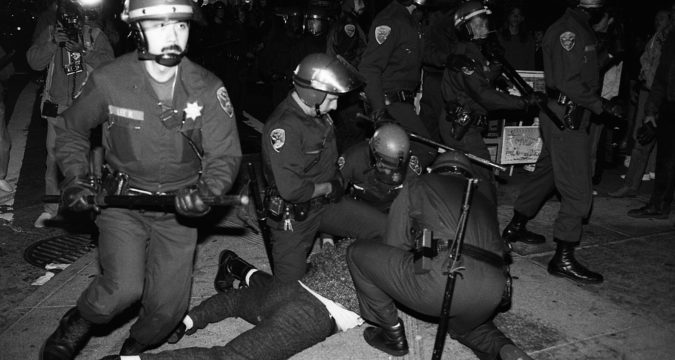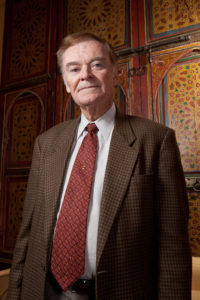
Cover Photo: Rick Gearharter, October 6, 1989.
It started out as a routine protest by the AIDS Coalition To Unleash Power (ACT/UP).
The organization had been staging regular protests to draw attention to governmental inactivity to address the AIDS epidemic. And the one on October 6, 1989 appeared to be like all of the others. But it turned into the single worst civil rights violations of LGBT citizens in the history of San Francisco, hearkening back to the White Night Riots a decade before, ultimately resulting in Police Captain Richard Cairn’s suspension, Deputy Police Chief Jack Jordan’s resignation, and the City paying hundreds of thousands of dollars in a class action suit against the City.
The protest and police response
The protest on October 6, 1989 was timed to be part of a nationwide demonstration. It started off routinely enough: speeches, some street theater, wrapping the columns of the Federal Building in red plastic tape to symbolize the bureaucratic “red tape” of Federal inactivity. Protesters were demanding increased funding for AIDS health care and research as well as streamlining the regulatory approval process for AIDS medications.
By 5:00 p.m., the protesters had moved to the sidewalk, planning to march back to the Castro as ACT/UP had done with their previous protests. But if ACT/UP’s protest was routine, following a pattern they had used safely many times before, the police department’s response was anything but.
Officers on foot and patrol cars prevented protesters from marching up a lane of traffic, as they usually did. When the protesters reached an intersection, the police didn’t stop cross-traffic as they usually did, but instead charged on motorcycles to keep protesters from moving until signals had changed.
Bill Haskell, ACT/UP’s police liaison, approached officers to introduce himself and discuss the police department’s crowd control techniques. In response, he was thrown to the ground, hand-cuffed, and arrested.
The protesters continued to march peacefully the nearly two-mile route back to the Castro where they planned, like numerous previous protests, to briefly block an intersection, chant some slogans, and go home.
Martial law in the Castro
Word passed through the crowd that their destination as usual was the intersection of Market and Castro Streets. They planned to stop traffic for a few moments, give a few short speeches and lead the protesters in chants, and then disperse.
The police usually assisted in quickly getting things back to normal by having a few officers on foot divert traffic around the protest and let it quickly come to an end. But this time, the police themselves had stationed dozens of office and police cars at the intersection, forcing the protesters onto Castro Street.
In an interview with the Bay Area Reporter for the 20th anniversary, Brian Bringardner described it as a “military occupation of the Castro.”
While about 50 protesters sat on the street with arms linked, about 20 others staged an impromptu “die in.” Police moved in to arrest the protesters on the street before turning their attention to the crowds on the sidewalk. They ordered people to clear the streets, and then sent battalions of tactical officers in riot gear to march down the street and force people onto sidewalks.
And then the police charged. Bystanders on the sidewalk were trapped between the charging police and other police lines blocking the rear. A few managed to take refuge inside Castro stores, where they were trapped for nearly an hour. Others bore the brunt of the police brutality. Gerard Koskovich, an ACT/UP supporter and queer historian, recounts seeing an officer use his baton with a jabbing motion, an action that the Police Commission had banned after Dolores Huerta was nearly killed at a United Farm Workers protest a year before. One of the protesters, a 19-year-old named Michael Barnette, was taken on a stretcher to a hospital after being clubbed by an officer later identified by his badge number as Police Captain Richard Cairns.
The police announced that the entire neighborhood was declared that the entire block of Castro from Market to 18th had been declared an “unlawful assembly zone” – in essence declaring martial law on the neighborhood. Simply being outdoors was grounds for arrest. In response to the crowd’s chants, the police gunned their motorcycles and plowed them directly into the heart of the crowd that was trapped and had no way to disperse.
By 9:00 p.m., police declared a seven-block area of the neighborhood to be an illegal assembly. By 10:00 p.m., the police dispersed even though the crowds, though thinned, still remained.
The City responds
A total of 53 people were arrested during the protests, and 10 were seriously injured. Four police officers were treated for injuries.
The next night, about 1,500 to 2,000 people turned out to protest the police action. The protest was peaceful without any injuries or arrests.
Mayor Art Agnos ordered an immediate investigation. In a statement to the Bay Area Reporter, he said, “What I have heard is deeply disturbing and if even 25 percent of the allegations turn out to be true then what happened October 6 is unacceptable.”
The Office of Citizens Complaints, the independent police review board, determined that the “Castro Sweep” had been ordered by Deputy Police Chief Frank Reed. Half of the entire police department had been dispatched to handle a routine protest that in the past had required just a handful of officers to maintain order.
The aftermath
In response to the investigation, Police Chief Frank Jordan demoted his brother, Deputy Police Chief Jack Jordan, over the incident. Police Captain Richard Cairns was placed on administrative duty and later suspended. Deputy Chief Frank Reed was reprimanded and Captain Richard Fife was reassigned to the traffic bureau.
In November, Jack Jordan abruptly resigned from the police force – not over the Castro Sweep, as many believe today, but because it was determined that he had helped cover up police brutality in the Dolores Huerta incident a year before by authorizing documents to be removed from a police officer’s file.
Following his suspension, Police Captain Richard Cairns sued the City over how his disciplinary action was handled. But his career was washed up. In 2007, he was working as a fight promoter.
The City ultimately paid $250,000 in damages from a class action suit brought on behalf of those injured by police brutality.
Deputy Chief Frank Reed left the department in January of 1996 and now works as an independent security and investigations professional.
But the Chief of Police, Frank Jordan, didn’t face any consequences for the action that involved half of his department, somehow (allegedly) without his knowledge. In 1991, he ran for Mayor against the incumbent, Art Agnos, and defeated him. He lost his own reelection bid in 1995 to Willie Brown, longtime Speaker of the California State Assembly.
Sources
Bajko, Matthew S., “20 years ago, police shut down the Castro,” Bay Area Reporter, October 1, 2009.
“California in Brief: San Francisco: Police Chief Forces Brother Out,” Los Angeles Times, November 15, 1989.
“California in Brief: San Francisco: Police Chief Will Discipline Brother,” Los Angeles Times, November 11, 1989.
Hemmelgarn, Seth, “Vigil to mark Castro Sweep 25th anniversary,” Bay Area Reporter, October 2, 2014.
Koskovich, Garard, “Remembering A Police Riot: The Castro Sweep of October 6, 1989,” FoundSF, 2002.
Palmer, Waiyde, “Today is the 23rd Anniversary of the Castro Sweep: Looking Back on that Historic and Infamous Night,” Hoodline, October 6, 2012.
Reed, Frank: LinkedIn Profile.
